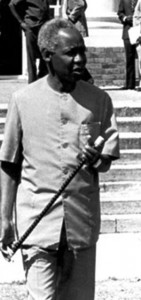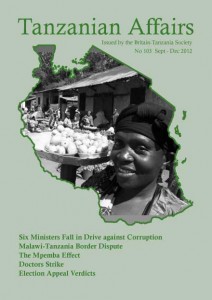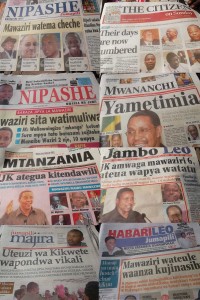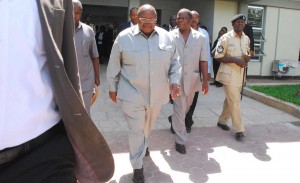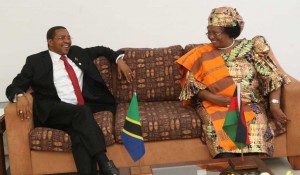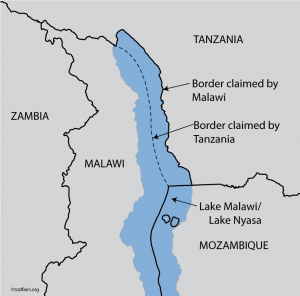Edited by John Cooper-Poole
THE CULTURE OF COLONIALISM. THE CULTURAL SUBJECTION OF UKAGURU, by T.O.Beidelman, Indiana University Press 2012. ISBN 978 0 253 00215 0 (h/b) £59.00, or p/b £20.99.
Some 35 years ago I read Beidelman’s Colonial Evangelism, a sardonic account of the Church Missionary Sociery in Tanganyika. (In this new book Beidelman describes how a good friend of his responded to the intrusion of a missionary into the club by urinating on the man’s trousers and Beidelman’s earlier book was written in much the same spirit). Since then I had read nothing by Beidelman and the appearance of this new book took me by surprise. I had assumed Beidelman was retired or dead but this book reveals him as very much alive. In fact it is surprising that I never met Beidelman. We both arrived in Africa in 1957, he to Ukaguru and I to Southern Rhodesia. We were both working on doctorates for Oxford. When I was deported from Rhodesia and came to the University College of Dar es Salaam in 1963 Beidelman was still out in the central Tanganyikan bush. Had he then met me on one of his infrequent visits to Dar es Salaam he would certainly have been as justifiably rude to me as he was to large numbers of dignitaries in Oxford and Tanganyika. In those early Tanzanian years I represented perfectly the sort of person about whom he is most scornful – intellectuals who believed that history was being made from the centre by the enlightened socialism of Julius Nyerere and who knew nothing of local realities. Beidelman is unsparing about Nyerere. His ‘Fabian Socialism’ was bogus and irrelevant; his sham rhetoric concealed an absence of constructive ideas; his forced villagisation policy had disastrous effects on local societies; he ruthlessly repressed all criticism, giving the ‘thugs’ of the TANU Youth League a free hand.
Yet this is a book about colonialism rather than post colonialism and its real indictment is of British colonialism in Tanganyika. Beidelman comes over as a natural rebel. He was wonderfully cheeky to authority. In Oxford he was splendidly impertinent to the majestic Dame Margery Perham, telling her in a seminar that her ideas about Indirect Rule were a dangerous distortion. He was rude to the arrogant District Commissioner in Ukaguru, and equally disobliging to a more sympathetic official who wanted to draw upon his anthropological knowledge. He made very few white friends until he had obtained his Oxford doctorate and had acquired an array of collegiate suits and ties and a strained Belfast accent. He quarreled with a paranoiac Tanganyikan local administrator. His affection and admiration were reserved for the Kaguru themselves, a lovable if fractious people living in beautiful country. They have always been the victims of history. His deepest wish – though not a lively expectation – is that they should enjoy a happier future.
The Kaguru were victims of slave raiding in the nineteenth century. German rule was brutal; the first world war destructive. The British portrayed themselves as more sympathetic rulers, gradually civilizing the ‘natives’ through the use of their own institutions in the policy of Indirect Rule. The core of Beidelman’s book is an exposure of the fraud of Indirect Rule. In a comparative chapter he reviews the very extensive literature on colonialism, usefully avoiding jargon. He admits that many others have exposed the illusions and self-delusions of Indirect Rule, with its invention of tribes and its self-deceiving smokescreen around the realities of force and exploitation. But he reasonably claims to provide the most thorough study of the functioning – or malfunctioning – of Indirect Rule in one district. Beidelman is scathing in his portrayal of the heroes of Indirect Rule. He sees Perham’s idol, Lord Lugard, as a man with neither knowledge nor ideas, transformed into a sage whom all colonial officers had to read. He sees the hero of Tanganyikan Indirect Rule, Sir Donald Cameron, as a desk-bound bureaucrat, ignorant of realities on the ground. Governor Twining was an inflated disaster. Beidelman’s rare compliments are reserved for critics of the system, like Dundas, or the last Governor, Turnbull, who wound colonialism up in Tanganyika with tact and common-sense.
In Ukaguru the imposition of the Indirect Rule system was made more difficult by the existence of matrilineality which the British did not understand or admire. (The new rulers after Tanganyikan independence just abolished it altogether). There were no ‘big men’ with hosts of dependants or dozens of slaves. Authority in the local Indirect Rule system was up for grabs and Beidelman has excellent chapters on how men emerged as headmen and some as chiefs. They were illiterate and uneducated men and no attempt was made to train up a group of literate younger Kaguru. Education was left to the disliked CMS missionaries who themselves were determined not to produce African intellectuals and made no effort to understand Kaguru ritual or religion. The core of Indirect Rule in Ukaguru was the system of headmen’s and chiefs’ courts. These could not try serious crimes and witchcraft was not recognized as a reality by the British. They were mostly concerned with civil cases. Soon after independence, Beidelman was given the surviving court records by a British official who told him that with the abolition of both chiefs and matrilineality no-one would ever be interested in them again. The core of his book is a discussion of these court records from which he reconstructs a vanished world. These chapters will be of inestimable comparative value to historians working on colonial legal systems.
Kaguru disliked and resented colonialism and Beidelman made friends just by virtue of not being British. But they did not fit into a conventional anti-colonial narrative. They did not participate in Maji-Maji. They did not resist either the Germans or the British. When it arose the nationalist party, TANU, was unpopular in Ukaguru. Instead, local disaffection with Indirect Rule was expressed by purely local associations which Beidelman valuably describes. In short, the Kaguru were totally unprepared for independence. TANU owed them no debts. Their culture and that of the other ethnic groups in Ukaguru was despised and often attacked by the ‘thugs’ of the TANU Youth League. They could not contribute informed and educated men to the new administration. British colonialism had not been brutal or racist but it had done nothing to prepare the Kaguru for modernity. Beidelman is glad that he left before the imposition of forced villagisation which finally destroyed the Ukaguru he knew. It is a sad story. It is also a very well told one.
Terence Ranger
Professor Terence Ranger was the first Professor of History at University College, DSM, 1963-1969. He is currently Emeritus Professor at the University of Oxford and has been a member of the Britain-Tanzania Society for over thirty years.
RADIO CONGO – SIGNALS OF HOPE FROM AFRICA’S DEADLIEST WAR by Ben Rawlence. Published by One World. ISBN 978-1-85168-927-9
This is a readable and attractive paperback. The author is an intrepid 30-ish researcher at Human Rights Watch who studied at SOAS and the University of Dar es Salaam. He has been a member of the Executive Committee of BTS. If you steam up or down Lake Tanganyika the Eastern Congo hills are not so distant; ‘ports’ like Kabimba and Kalemie might just about be discernible from the deck of the SS Liemba. Once scuttled by the Germans, it took the British over five years to raise Liemba which is now destined to become a maritime museum.
The clear Victorian-type map at the front is essential to following this journey. He flies in and out of Kivu, then uses jeep, motorbike, back of bike, boat, canoe and foot to reach his destinations in Eastern Congo, mainly Katanga. Ben Rawlence wears his Swahili skills and learning lightly to illustrate the way the language has spread so far into the Congo, brought there by the coastal slave traders. The beauty and horror of the Congo and its suffering inhabitants are all too apparent on this journey, each part of which had to be separately planned as the economy has virtually collapsed since 1960. Thus a hundredweight of silver ore from Manono, his destination, is the load for one bicycle, ploughing through the bush of overgrown roads. His currency is dollars and cigarettes usually.
Even in Congo, Catholic missions are still functioning in a residual way with quite imposing buildings often ruined. And so we come to his mecca, the once celebrated Manono, centre of silver mining for the Congo and elsewhere. He describes the gaunt, but enormous, buildings still hanging there, in the style of Lord of the Rings. Rawlence, at the beginning of this book, is eager to get down to the south-east of Congo where this book takes us. By contrast, after he has been at Manono for a while, he feels more like a prisoner, following the radio communications from other parts of Congo (his ‘Signals of Hope’) and cannot wait to hitch a flight back to Kivu.
I was gripped by Rawlence’s narrated conversations with different villagers and local notables; and by the fact that humans seem to need hierarchy even in anarchy. The potential for commerce from Eastern Congo across Lake Tanganyika to Kigoma seems enormous, if only the Tanzania end of the arrangements could be realised when things settle down and Tanzanians cease to fear Katangan competition.
His good book list could have included Helen Roseveare’s two late nineteen-sixties paperbacks on North East Congo which still draw a tear today.
Simon Hardwick
Simon Hardwick was an Administrative Officer in Tanzania 1957-1968 and Chairman of BTS Executive Committee 1995-2001.
TAIFA: MAKING NATION AND RACE IN URBAN TANZANIA by James R Brennan Ohio University Press, 2012. ISBN 9780821420010 p/b 304pp. £29.50.
“In this work, we will embark on a tour of identity categories …” (p.1). It is a mixed blessing that so much (rather good) modern African history is the work of American academics. On the plus side, it is meticulously researched and documented – witness Brennan’s 81 pages of notes and references; on the other hand, there seems to be an obligation to overlay the history with an intellectual gloss, in this case the language of identity.
That said, the story Brennan tells us is an interesting and important one, which continues to have troubling echoes to the present day. It concerns the relationship between Africans and the Indian community in Dar es Salaam, both before and after independence in 1961 – the period covered is roughly 1916 to 1976. And, of course, the pattern of relationships between communities established by the British administration set the tone. As Brennan observes, “Examined closely, East African ‘Indians’ splinter into a dizzying array of regional, religious, and caste-based communities” but “If considered as a microcosm, [they] appear to be a privileged community that, by and large, had profited from their participation in systems of colonial rule.” (p.3).
Chapter 1 brings out how, in the inter-war period, the need to distinguish between ‘native’ people (to be protected from exploitation by outsiders) and ‘non-natives’ posed difficult problems for the administration, particularly on the coast and in the capital, given the dominance of the latter in government, business and (in the case of the Indian community) in retail and wholesale trade. In Dar es Salaam, this resulted in the ostensibly non-racial division of the town into Zone I (high standard residential), Zone II (commercial) and Zone III (reserved for natives). Zone II was predominantly Indian and it was “Indians, not Europeans, [who] interacted with Africans on a daily basis and bore the brunt of African frustrations with the cruel vicissitudes of market economics.” (p. 34). However, as Brennan skillfully points out, there were contradictions inherent in these arrangements, particularly as regards housing, trade and land laws, aggravated by the relocation of the main market from Zone II to Kariakoo in Zone III.
Chapter 2 develops these themes as they affected racial identities in Dar, giving impetus to the consolidation of an Indian identity (at least in the eyes of Africans), notwithstanding internal differences in that community. At the same time, a similar consolidation of African identity was taking place, over-riding previous distinctions, such as those between Shomvi (Arab-descended) and Zaramo, or between Wenyeji (original residents) and watu wa kuja (newcomers).
WWII pushed these tendencies further (Chapter 3) as the authorities sought to maintain an orderly urban environment in the face of rising living costs, food shortages and growing militancy on the part of organized African labour. The responses included price controls, and creation of minimum entitlements to food, textiles and housing for recognized residents, which “dramatically raised the political and economic value of urban space” (p.117). This in turn led to attempts to curb in-migration, with limited effect, extending even to repatriation of wahuni (young, unemployed ‘hooligans’) – a policy revived subsequently, both before and after independence, indeed right up to the present day.
Chapter 4 charts how, in the post-war period, the Swahili term taifa (nation) came to eclipse kabila (tribe) and other sub-categories, helping to weld together the diverse groups making up the African population into a Swahili-speaking nation. Lively debate ensued as to whether Indians or people of mixed descent could properly belong to the taifa. In this discussion, Nyerere’s vision of a relatively colour-blind nation sat uneasily with TANU’s (pre-independence) African only recruitment policy and the growing demonisation of Indians as exploiters (unyonyaji).
By Chapter 5 these trends culminate in, on the one hand, the abolition soon after independence of the office of chief, part of a general suppression of tribalism (and hence of indirect rule); and, on the other hand, in the 1971 nationalisation of all buildings worth more than 100,000 shillings and not entirely occupied by the owner. “Everyone knew this to mean the expropriation of what was overwhelmingly Indian-owned residential and business property.” (p.191). While this was less harsh than Amin’s expulsion of Indians from Uganda, or Banda’s incitements against Indians in Malawi, it was nevertheless a severe blow, leading to a substantial exodus and, one imagines, not inconsiderable damage to the urban economy.
Economists may glumly note the contribution of misguided urban policies to this outcome. As Brennan puts it, “In urban areas like Dar es Salaam, the postcolonial state chose to continue its predecessor’s urban policies of relying on price regulation and movement restrictions rather than committing the necessary investments to manage urban growth.” (p.194). In particular, the shortage of accommodation and the pressure of in-migration combined to raise rents to very high levels, not offset by effective taxation of property to fund improvement, lending weight to accusations of unyonyaji against the (mainly) Indian landlords. (Nor did it help that the city council was disbanded in 1974, a development branded as “an unmitigated disaster” by Brennan “directly resulting in the collapse of basic urban services, such as garbage and cesspit disposal.” (p.198).)
One may ask how far invoking the language of identity adds to our understanding of the events described. Brennan is not a heavy theorist and charting the evolution of the way in which key words were used and understood does throw light on changing attitudes. But, to a large extent, the story tells itself – and a gripping story it is, particularly in the hands of someone as scrupulous as Brennan. One is left hoping that equally engaged researchers may now take the story forward to more recent times, moving away from unearthing overlooked details from colonial era records (fascinating as that is) to, for example, exploring the implications of the emerging gap between the urban haves (the naizi) and the have-nots (the kabwela or urban poor), tantalizingly mentioned towards the end of the book; or, more ambitiously, helping us to better understand the reasons why the process of urbanization in Tanzania (and many other African countries) is not delivering the benefits that it should.
Hugh Wenban-Smith
Dr Hugh Wenban-Smith was born in Chunya and went to Mbeya School. His career was as a government economist – mainly in Britain but with periods in Zambia and India. He is now an independent researcher, with particular interest in infrastructure, urbanisation and transport.
ORCHIDS AND WILDFLOWERS OF KITULO PLATEAU by Rosalind
F. Salter and Tim R.B. Davenport. Princeton University Press 2011 ISBN 978 1903657348. £14.95.
This attractive small book produced by WILDguides Ltd, is a convenient A5 size, with soft covers and numerous coloured photographs. Profits from its sale go towards the conservation of the Southern Highlands of Tanzania and support the people who live there.
The introduction gives a broad picture of the uniqueness of the plateau’s natural history – mainly the thousands of brightly coloured flowers many of which are restricted to this area, but also mentioning the rare lizards, frogs, birds, antelopes and Africa’s rarest monkey, the kipunji, only discovered on nearby Mount Rungwe in 2003. The reasons for its urgent designation as a national park – a growing trade in orchid tubers as a delicacy- are also given.
Brief descriptions and photographs of the main habitats give an idea of the extent of the plateau. 112 species are described, giving distinguishing features together with points of interest such as distribution, abundance and flowering time. Each one is illustrated by an excellent photograph. In addition there is a glossary to aid identification, a list of contents and a bibliography.
This would be an excellent guide for anyone who was visiting Kitulo Plateau especially in the wet season (November to April) when most of the flowers are at their best.
Rachel Nicholson
Rachel Nicholson, accompanying her husband, lived in Tanzania and Nigeria for twenty eight years, fifteen of which were in Mbeya. Walks in the Southern Highlands with Phil Leedal gave her, like many others, a special interest in the plants of that lovely area.
THE EVOLUTION OF AN AFRICAN MINISTRY IN THE WORK OF THE UNIVERSITIES’ MISSION TO CENTRALAFRICA IN TANZANIA 1864 – 1909.
London PhD Thesis 1984 by Jerome Tomokazu Moriyama, Re-published by Issui-sha Co. Ltd, Japan, 2011. ISBN 978-4-900482-39-5
Dr Moriyama was a lecturer at St Mark’s Theological College, Dar es Salaam from 1973 to 78. His research covers the first 45 years of UMCA work. It reveals how the original vision for Christian ministry was steadily lost – “that an African Church must be founded, spread and worked by Africans themselves. The business of its European members is to do their best to start them on this career, help as they may, and then pass out of sight.”
UMCA was founded in 1861. Its Cathedral was built on the site of the slave market in Zanzibar. Early work in Zanzibar involved caring for and schooling children rescued from slavery, and establishing a settlement for released slaves to live in. It was hoped this work might produce the first generation of Christian leaders to be sent back to the mainland.
From the earliest days each bishop affirmed the essential need for well-educated African leadership in the new churches, but there was little effective strategy to achieve it. Tozer in his eight years as bishop ordained no one. Whereas Tozer used only English in education and public worship, his successor, Bishop Steere soon produced a Swahili Grammar, New Testament, Liturgy and Hymns. A college was started to train young men either as teachers or for church ministry. Mainland missions were established at Magila near Korogwe and at Masasi in the south.
UMCA differed from the majority of Anglican missions, with its emphatic commitment to Anglo-Catholic priesthood, teaching and spirituality. Authority was devolved to the bishop in the field rather than a home committee. Each bishop adopted his own strategy, some in favour of entrusting pioneering work to its first ordained clergy and evangelists, others placing them under the local supervision of missionaries. Freed-slave clergy on the whole found it impossible to gain the respect of the Arabs who controlled the main centres and routes; and being strangers, sometimes failed to win the support of the local chiefs.
These problems notwithstanding, this study details the success of many such clergy. They were physically fit, could cope with harsh climates, accepted local standards of living, learned local languages, and comprehended and respected local cultures. One example is highlighted: the ministry of the Rev Cecil Majaliwa, the first deacon, then priest, to be ordained, who worked in the Masasi area 1886-1896. (He was Archbishop Ramadhani’s grandfather) Totally committed to the local people, with the goodwill of the chief, he was an example of Christian faith and behaviour. Churches grew under his ministry, but to the envy of the missionary in charge, who observed his success and rapport with the local people. Majaliwa lost the vital backing of a new chief, and coupled with the indecisiveness of Bishop Richardson over his request for leave, he returned independently to Zanzibar, never to be sent out again to the mainland.
His experience reveals the key failure of UMCA to support the clergy they trained, and their insistence on missionary supervisors. Yet even in the Masasi area in the 1905 -7 Maji-Maji uprising, when the missionary workforce withdrew, the church continued to grow strongly under its African clergy – as happened also during the 1914-18 War.
In UMCA, the highest one could aspire to was rural parish work, following a long diaconate and a good level of theological training. Too late, Bishop Frank Weston 1908 -1924 realized his mistake. Capable clergy had been dismissed over disputes with inexperienced missionary priests. UMCA made little effort to examine such cases. Paternalism prevailed. No clergyman was appointed archdeacon or bishop in the entire colonial period and none was sent to England for further training following Cecil Majaliwa.
All this makes salutary reading for any who have been involved in clergy training in Africa in more recent years. It is a story of a wonderful vision which somehow was never attained.
Christopher Carey
The Rev Christopher Carey worked with CMS, the Church Mission Society, in Kenya and London, where he was Regional Secretary for East and Central Africa. Following parish work in Lincolnshire he retired in 2004.
TWILIGHT OF THE BWANAS by Gordon Dyus. Published by Xlibris Publishing 2011. Order from www.amazon.co.uk. Price £13.99 p&p free UK, £4.99 Europe, £5.49 ROW pb 196 pages ISBN 978 1 4653 6653 5
The parents of the author of this study kept their young son with them in East Africa throughout the Second World War, rather than (as happened to many of our contemporaries) leaving him in what was expected to be the temporary care of relatives in Britain, only to be separated altogether for five formative years. Gordon Dyus’ father worked successively for the port authorities of Mombasa and Dar es Salaam, and from a very young age Gordon shared your reviewer’s experience of being sent off to attend boarding school in Nairobi.
Although informed and animated by numerous personal memories, Twilight of the Bwanas is not so much a biographical memoir as an individual’s observation of colonial life at that time and during the postwar period. In this, it is inevitably restricted to some extent by the direct observations of the writer: but there are many perceptive comments and observations — not least about the colonial “memsahibs” to whom so very many “bwanas” and their children owed so much. Dyus notes, for example, that apart from some sections of the Kenya settlers there was in East Africa very little racism, as it is understood it today. Each group — Europeans, Asians and Africans — tended to accord full respect to the others, whilst not seeking to intrude upon them, nor to interfere with their habits and customs. Rivalries and “class distinctions”, as he points out, were very much more apparent within the various groups. My own father recalled a civil service dinner party at which the host barked: “Seat yourselves according to your salaries!” and relished the fact that it was the wives of the various officers who all knew exactly where to go!
This first half of the book, describing colonial life during and after the war, is evocative and rewarding, even though the author tends occasionally to assume too readily that his readers will share his familiarity with what he is describing: the layout of streets in Mombasa or Dar es Salaam, for example. Moreover, the vivid descriptions in the book cry out for illustrations; and it is odd that someone who became a surveyor with Tanganyika’s admirable Department of Lands and Surveys should not have helped his readers by including a few simple maps and plans.
The book’s sub-title claims to describe life in East Africa before independence. And, as remarked, the first half does that admirably — principally as regards Tanganyika. The ensuing chapter about the actual attainment of self-rule is likewise well observed. But sadly in most of the rest of the book, besides describing excellently several more episodes of expatriate life, Dyus devotes too many pages to bewailing what he believes might have taken place if the process of transition had been less rushed. Many of us who were there would agree that these countries suffered — and continue to suffer — as a consequence of the unexpectedly abrupt termination of British rule. But any belief that this could have been avoided suggests a failure to understand what was going on at the time in the rest of the world, where Macmillan and McLeod were constrained both by domestic economic pressures and by the knee-jerk hostility to imperialism of their most powerful Cold War ally.
What is more, Tanganyika in particular was not a colony, but a former German territory entrusted to Britain by the League of Nations to be prepared for eventual independence. Once the majority of members of the United Nations, the League’s successor body, had come to the conclusion — however unrealistic – that the time for that independence had come, it became very difficult for Britain to argue convincingly that the country should nevertheless continue as a Trust Territory.
Some of us would also challenge Gordon Dyus’ portrait of Julius Nyerere. Certainly “Mwalimu” felt constrained to posture from time to time as a power-hungry demagogue; but the monster described in these pages is very different from the soft-spoken scholar who occasionally took refuge from politics in my parents’ home to discuss how best to recast Shakespeare in traditional classical Swahili verse forms. Again, it is easy with hindsight to ridicule Nyerere’s socialist economics. But this was the era of Harold Wilson’s Britain and François Mitterand’s France, when various forms of socialism were all the rage; and very many European and American scholars applauded ujamaa as a model for the entire African continent. Similarly, it is easy to mock the follies of the TanZam railway. But — again with hindsight — perhaps it may prove to have been quite a shrewd move to be the first African nation to make friends with the superpower that will almost certainly dominate the 21st century. Last but not least, Nyerere set a precedent — sadly rare in Africa — by stepping down from power before he was pushed.
Twilight of the Bwanas, then, is a book of two halves — one impressively and vividly evocative of the period of colonial rule, the other disappointingly prejudiced about the postcolonial period.
Hubert Allen (Uganda 1955-62)
This review first appeared in The Overseas Pensioner, No.104 of October 2012, the journal of the Overseas Service Pensioners’ Association. It is printed here with permission, which is gratefully acknowledged.
LIVE FROM DAR ES SALAAM: Popular Music and Tanzania’s Music Economy. By Alex Perullo. Indiana University Press, March 2012. p/b ISBN 9788 0 253 22292 3 £18.99.
One day in June 2007, looking for Tanzanian music to buy, I found myself in Dar es Salaam Music and Sport. The owner told me the shop had been the leading outlet for pop records when sales of recorded music were at their height. Apart from the fact that they were now empty, the glass fronted cases had not changed since the 1960s. The only music available, however, was a handful of doubtful-looking cassettes, some of which I bought. Considering, as Alex Perullo shows, music is central to Tanzanian life, avidly consumed whether as radio broadcast or live performance, this was both puzzling and disappointing.
I mention this incident for three reasons. One is that this same shop appears, in a section on Asian musical entrepreneurship, in Perullo’s admirably researched account of the ups and downs of Tanzanian music over the last fifty-odd years. It exemplifies the thickness of ethnographic detail in a study which must be one of the most exhaustive of its kind. And lastly, this is the way Perullo himself proceeds: with a personal anecdote which functions like an establishing shot, before pulling out to give us the wide-angle view on different aspects of his subject. The frequency of openings such as: ‘One afternoon, I sat…’, ‘I spent a great deal of time with’, ‘I worked closely with’, ‘I sat and watched entire recording sessions’, ‘I conducted a survey among’, etc, brings home the sheer extent of Perullo’s involvement with what he calls the Tanzanian music economy in all its many facets – history, ideology, performance, education and training, broadcasting, recording, sales and distribution, copyright and contracts – and the music itself in all eight of its genres as described in a useful appendix and illustrated in online links to a musical archive.
Of the sixteen years since deregulation in 1994 – the period the study covers in most detail – Perullo’s research coincided with twelve: 1998-2010. The result, as he says, is a longitudinal study, not only of the ‘dynamic interplay’ of multiple influences which have shaped Tanzanian music, but of the creative ways urban Tanzanians have adapted to social, political and economic change. He takes as his premise that ‘more attention should be directed at finding and exploring narratives that evidence achievement in African contexts,’ rather than the default outlook on Africa as impoverished and therefore unable to help itself (xix). The case he makes for Tanzania’s music economy as one of the most thriving in Africa (in a context where the notion of an ‘industry’, with its connotations of infrastructural support, does not apply), and an example of Africans making things happen for themselves, is well demonstrated and convincing. ‘Music economy’, he argues, signifies processes of commercialization and commodification by which musicians, record producers and distributors make a living, and audiences are connected to each other and to the wider world.
The means by which this is accomplished Perullo calls ‘creative practices’, self-generated schemes and strategies including ‘networking, positioning, branding, payola, bribery and belief in the occult’ (xii). Under this sign, even apparently negative practices like piracy and sabotage are recuperated as creative responses to lived material conditions. Piracy, for example, is shown to be ‘the simplest and most effective creative strategy in the music economy’, and central to its success (339). Always looking, as one of the chapter titles has it, at ‘the submerged body’ rather than surface appearance, Perullo deploys local terminology to show how such practices are socially determined and culturally understood by participants. He shows, for example, how the outrage of visiting foreign rappers at the apparent chaos at a recording studio was a reaction to surface appearance; going deeper, he uncovers the Swahili concept of hujuma, the ‘purposeful act of destroying or damaging something in order to hinder it from being successful’ (276) – in this case a subversive strategy by a producer to undermine a project from which he had been sidelined.
Such creative strategies are part of a ‘bongo mentality’ which enables people to survive and thrive in the competitive atmosphere of Dar es Salaam – Bongoland itself. What gives Perullo’s argument its impact and authority is his making the ‘autochthonous philosophies’ of ‘bongo (wisdom/ingenuity)’ (8) and kujitegemea (self-reliance, in both its socialist and neo-liberal manifestions) (10) the informing principle of his idea of ‘creative practices’. By the final chapter, ‘Everything is Life’, in which he looks at transitions taking place and their possible future implications, he has fully justified his approach. This chapter is a philosophical meditation on Tanzanian society as it is evolving in the face of increased insecurity, urban competitiveness and consumerism, and the breakdown of earlier forms of family and community. Ultimately, he argues, creative practices are a way of cheating death and an expression of desire. He takes issue with President Mkapa’s reading of the term bongo as over-reliance on government, seeing it instead as ‘the dynamic use of resources that people employ to better their lives’ (361). Through Perullo, we are given a unique insight into the manifold uses of art and artifice by which people shape their own lives in an African city today.
Jane Bryce
Jane Bryce was born and brought up in Tanzania, and educated there, the U.K. and Nigeria. She is Professor of African Literature and Cinema at the University of the West Indies, and the author of Chameleon and Other Stories reviewed in TA No. 88 (Peepal Tree Press).

